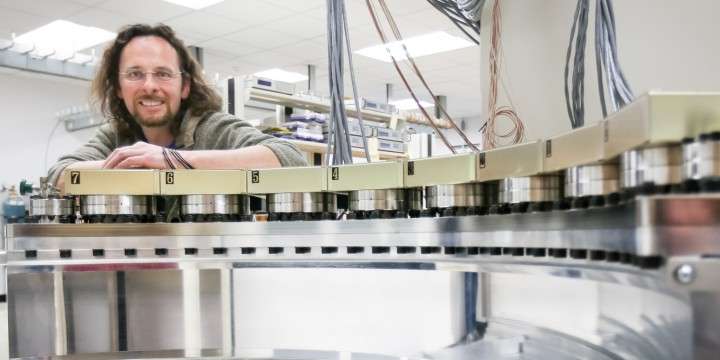New 2-D detector promises expanded neutron scattering capabilities for WAND users

The WAND instrument, beam line HB-2C, at Oak Ridge National Laboratory's High Flux Isotope Reactor, recently received a new detector for improved characterizations of materials in extreme environments at the microscopic level—courtesy of Los Alamos National Laboratory. Both ORNL and LANL are Department of Energy laboratories.
WAND instrument scientist Matthias Frontzek says the renewed role of the re-serviced 2-D detector will enable researchers to build 3-D images, designed to help track changes in magnetic behavior in experiments using single crystals.
"What was once not visible before suddenly becomes visible because of the detector's ability to pick up on the subtle shifts in a system," Frontzek said.
Frontzek says the new detector not only captures larger portions of reciprocal space needed for specific types of magnetic characterizations, but it also enables neutron scattering to be captured in a wider range of directions. The new capability is expected to further bolster the instrument's ability to create a more complete blueprint of the crystallographic properties of new materials.
"Right now, we can only capture the equatorial plane of the scattered neutrons from a sample, but a 2-D position-sensitive detector will give us the information we need as to how a neutron scatters vertically," Frontzek said. "That way, we don't have to lose time in changing the crystal orientation to get the full picture."
For Frontzek, the new detector is a powerful resource for growing and maintaining a stream of engaged users for the instrument, including researchers who may not have considered using WAND before.
"I think the instrument's data acquisition rate and new capabilities will attract those in material sciences and in-situ chemistry, where you study the changes in material and characterize the changes that you observe at a fundamental level," he said.
Frontzek expects the upgraded WAND will be available to users by spring of 2018 once the installation and commissioning process is completed.
"The detector doesn't transform the instrument into a brand new instrument, but it does increase its ability to problem solve and examine structural relationships that we have not observed before," Frontzek said. "I'm thrilled to see where it will lead others who come to the lab to implement their ideas."
Provided by Oak Ridge National Laboratory



















